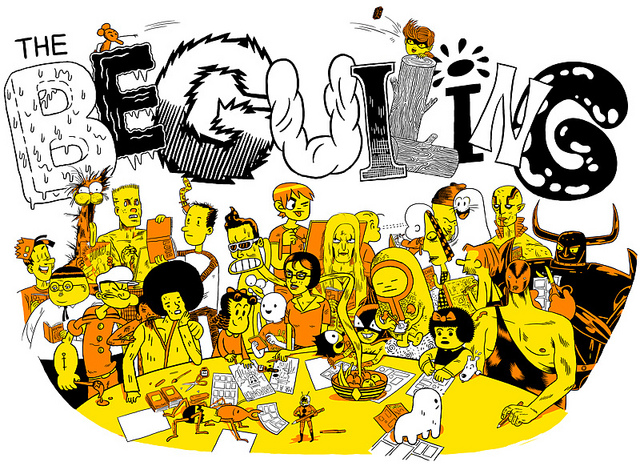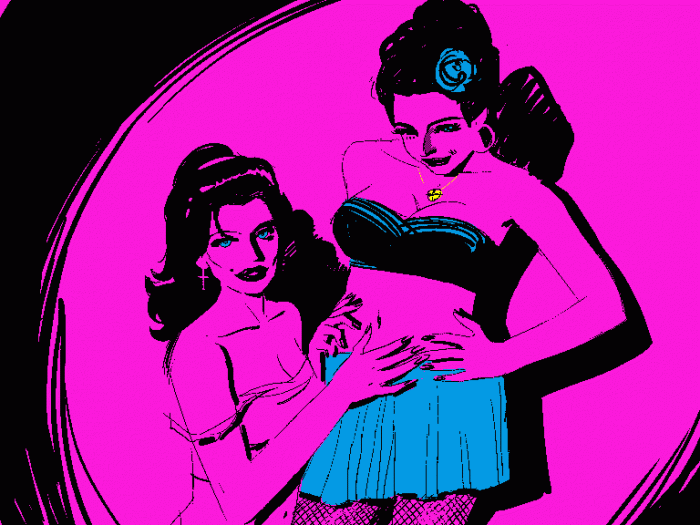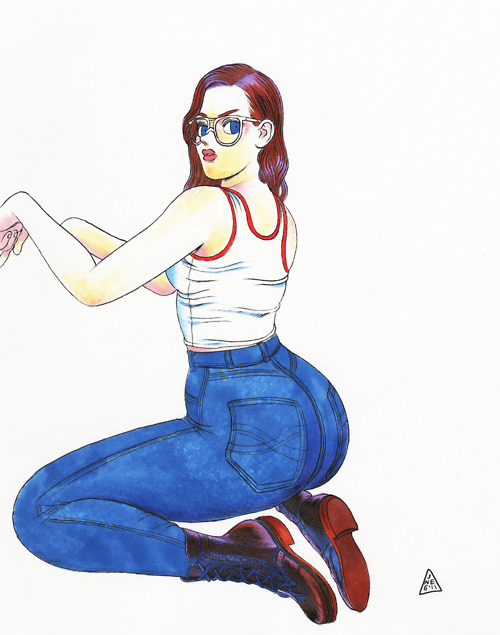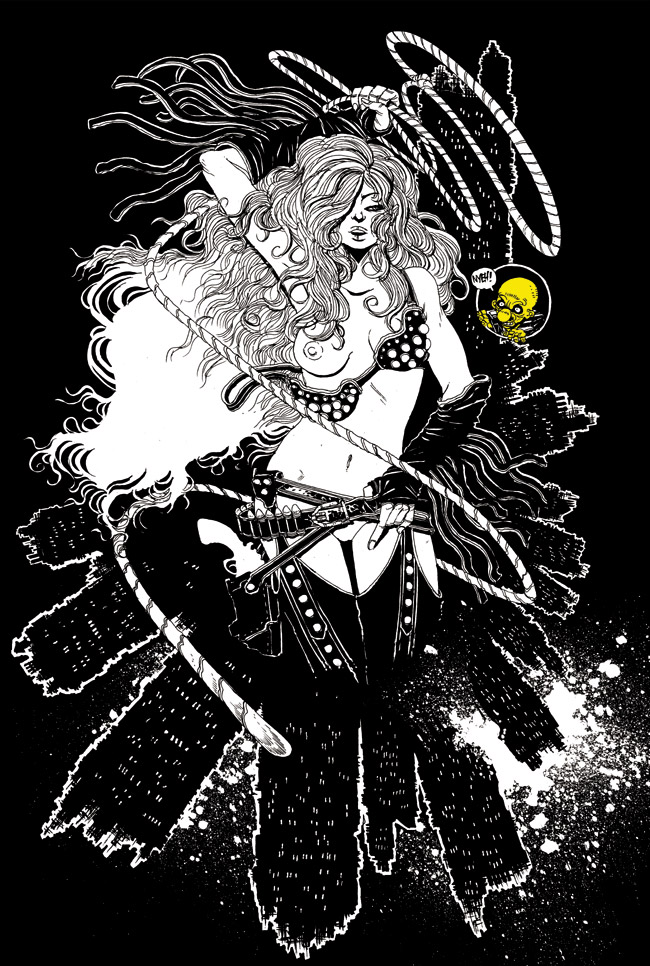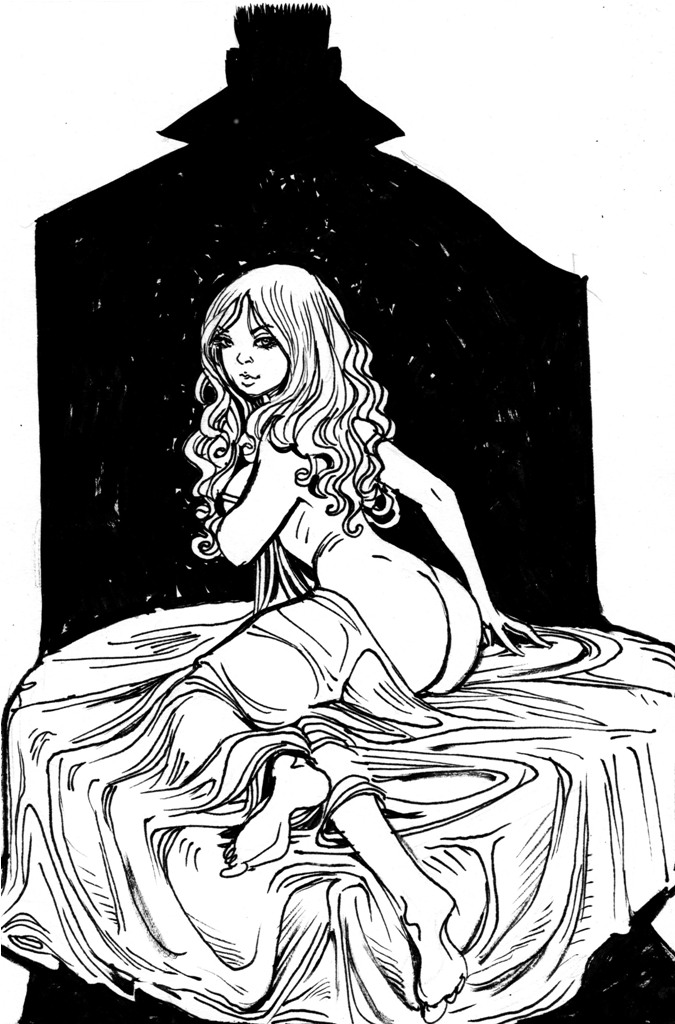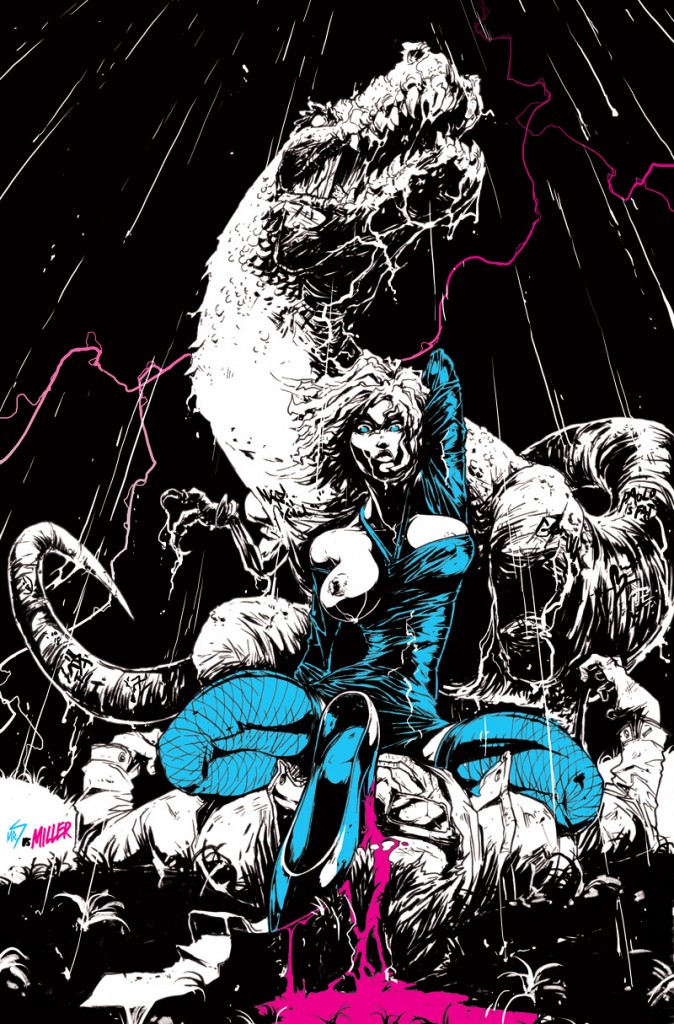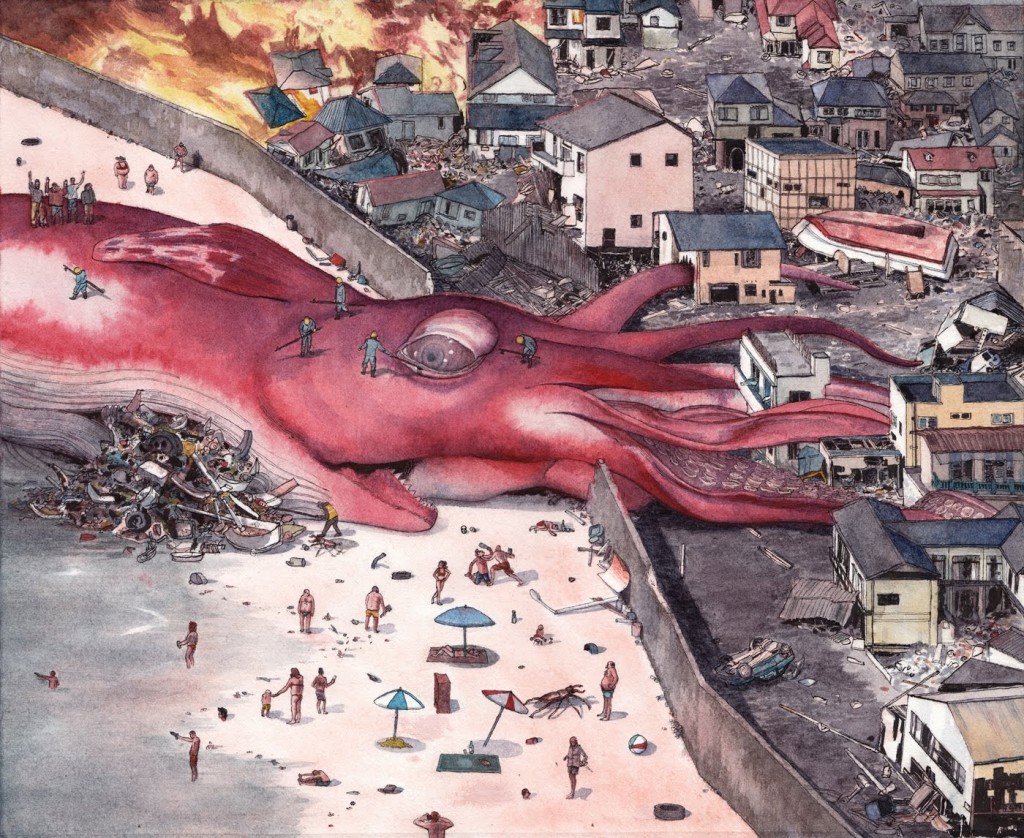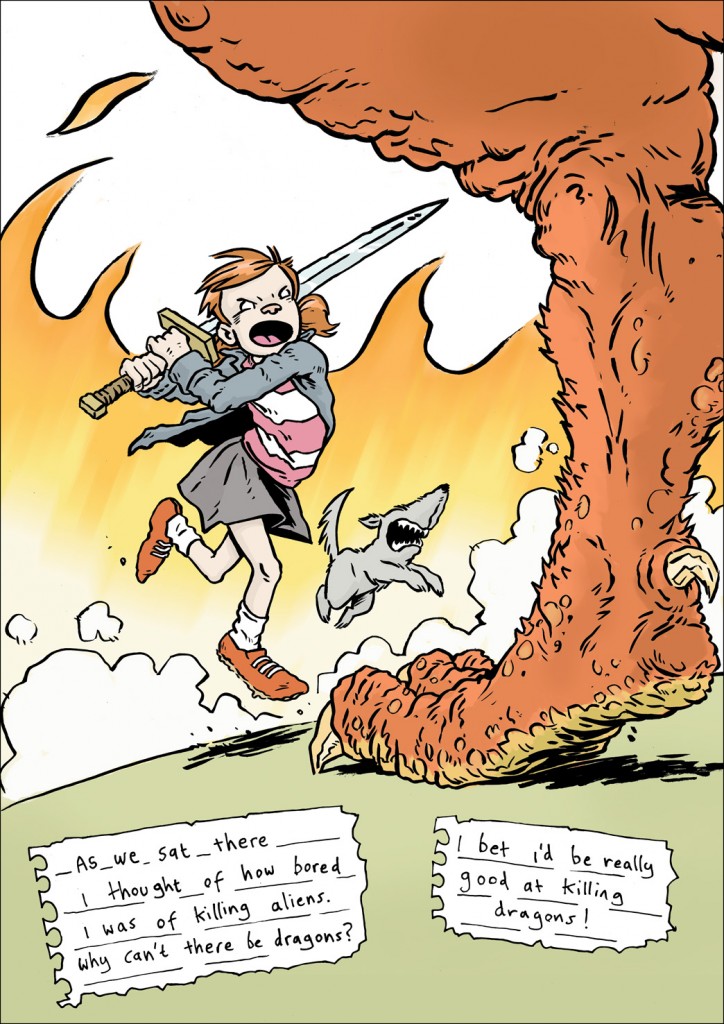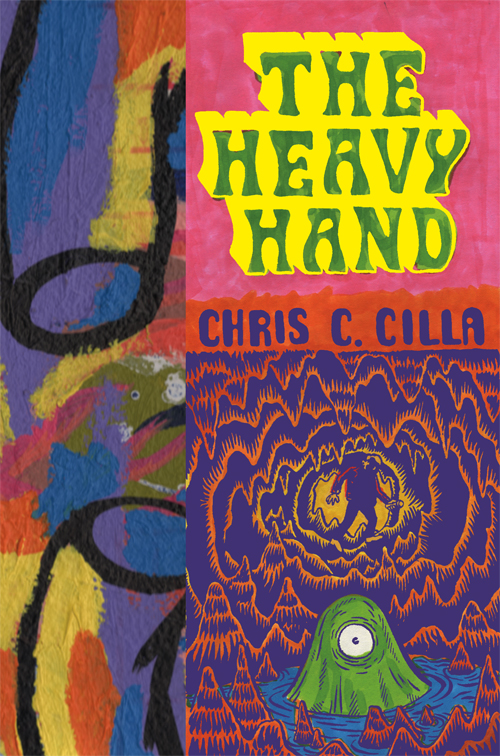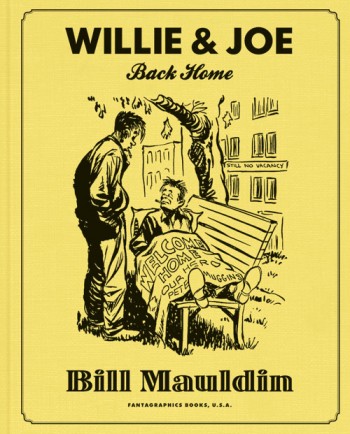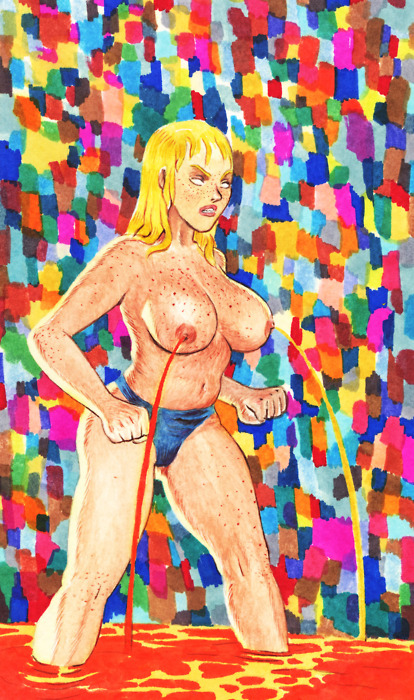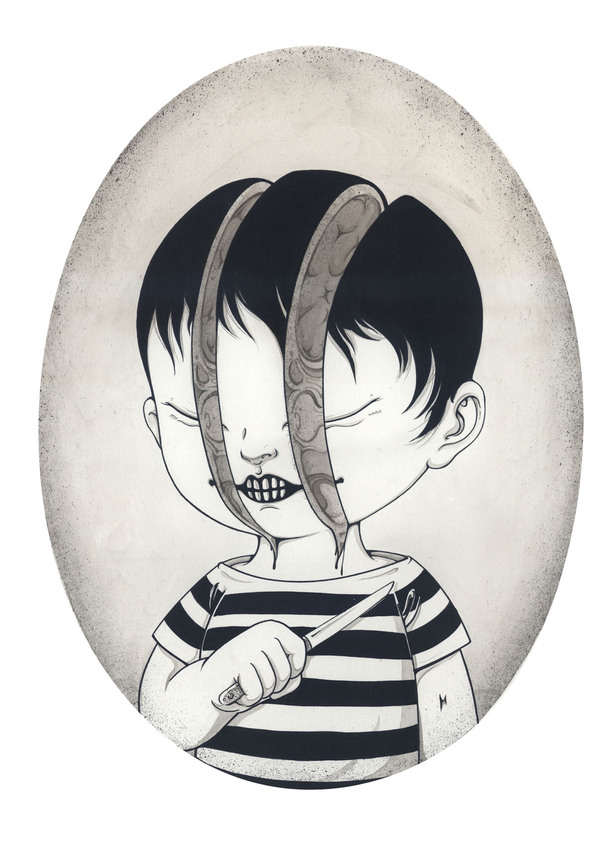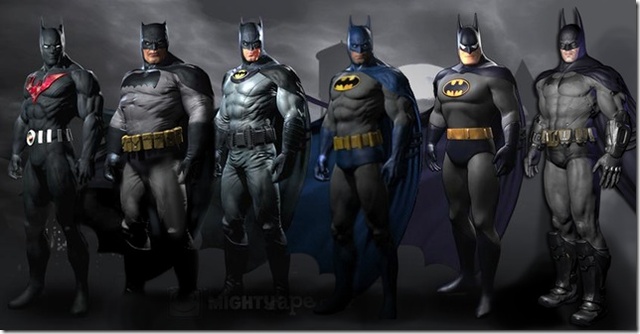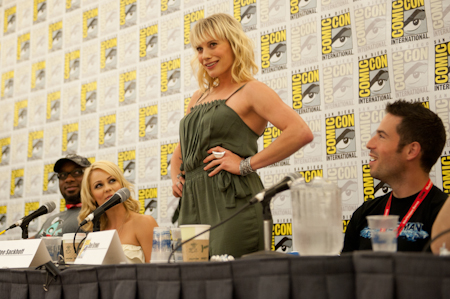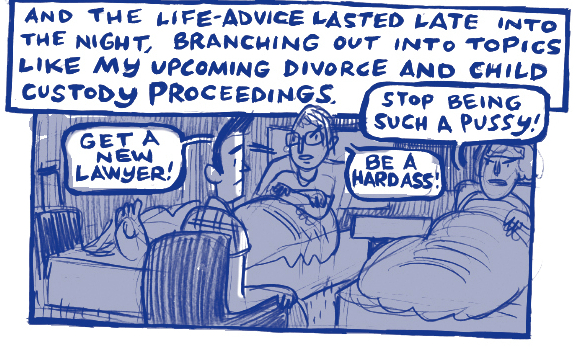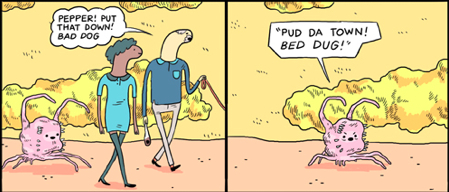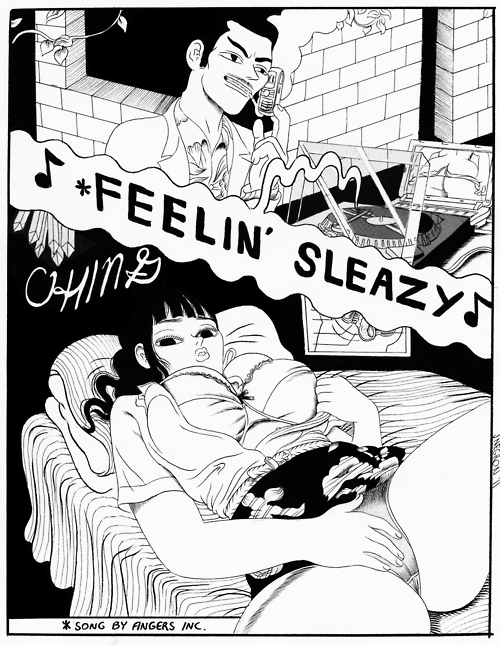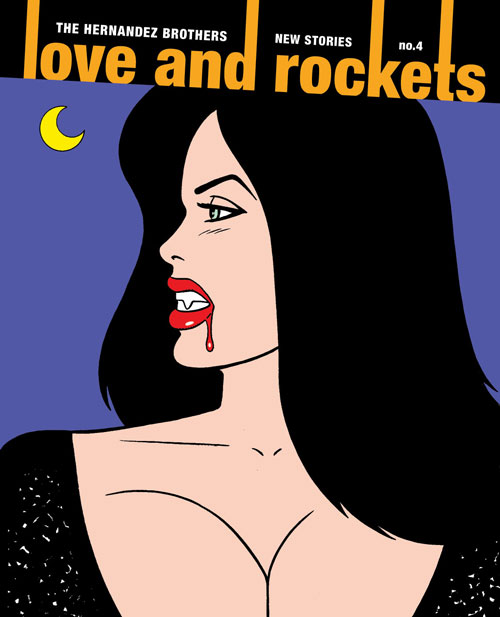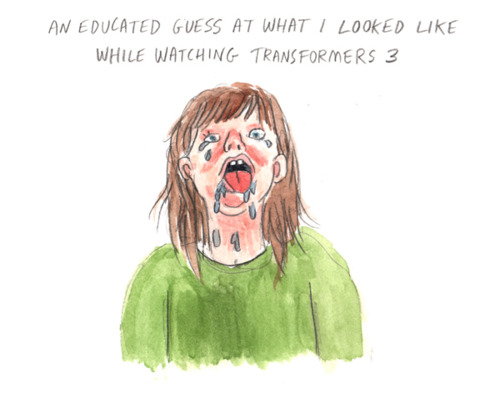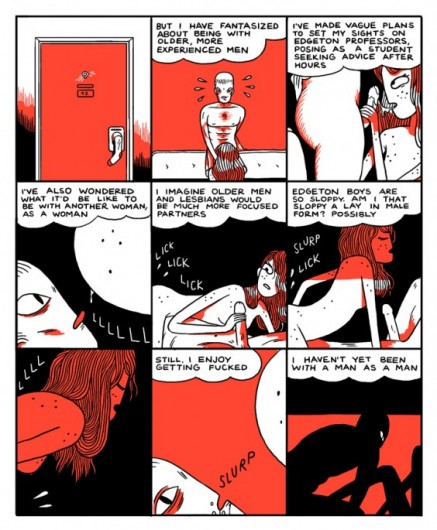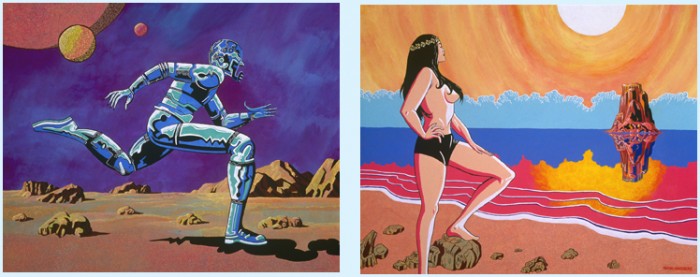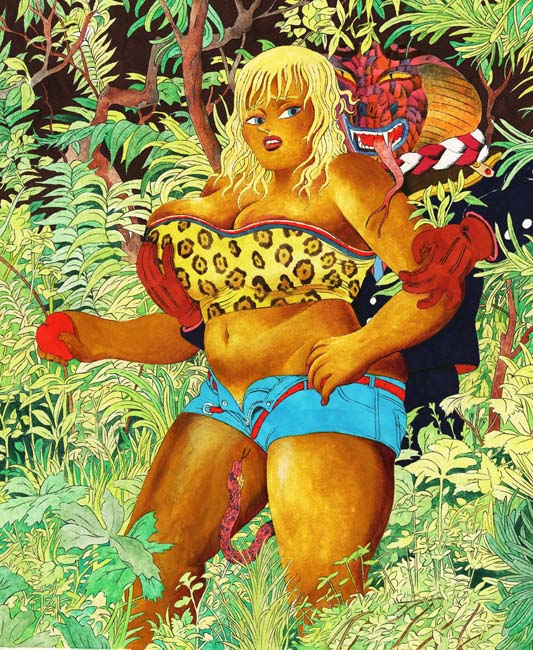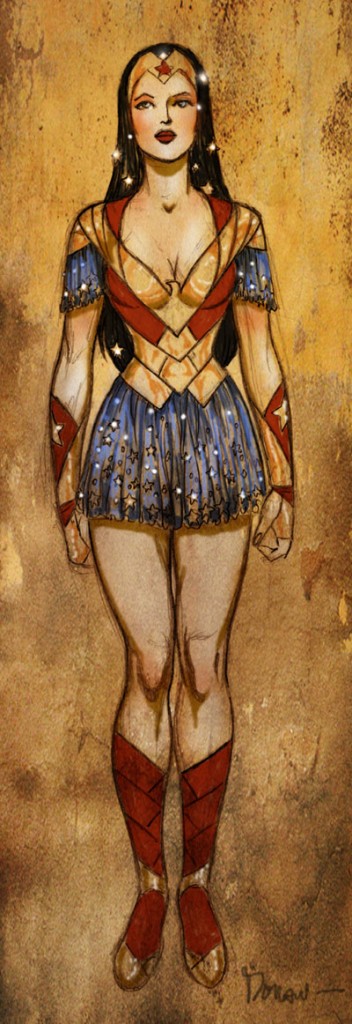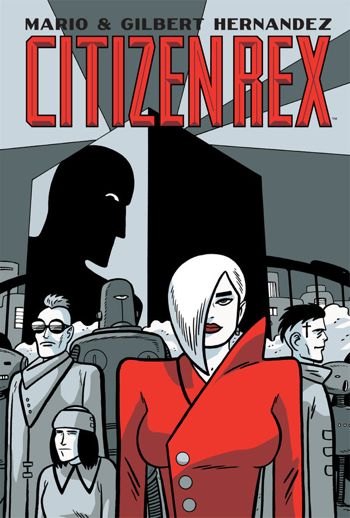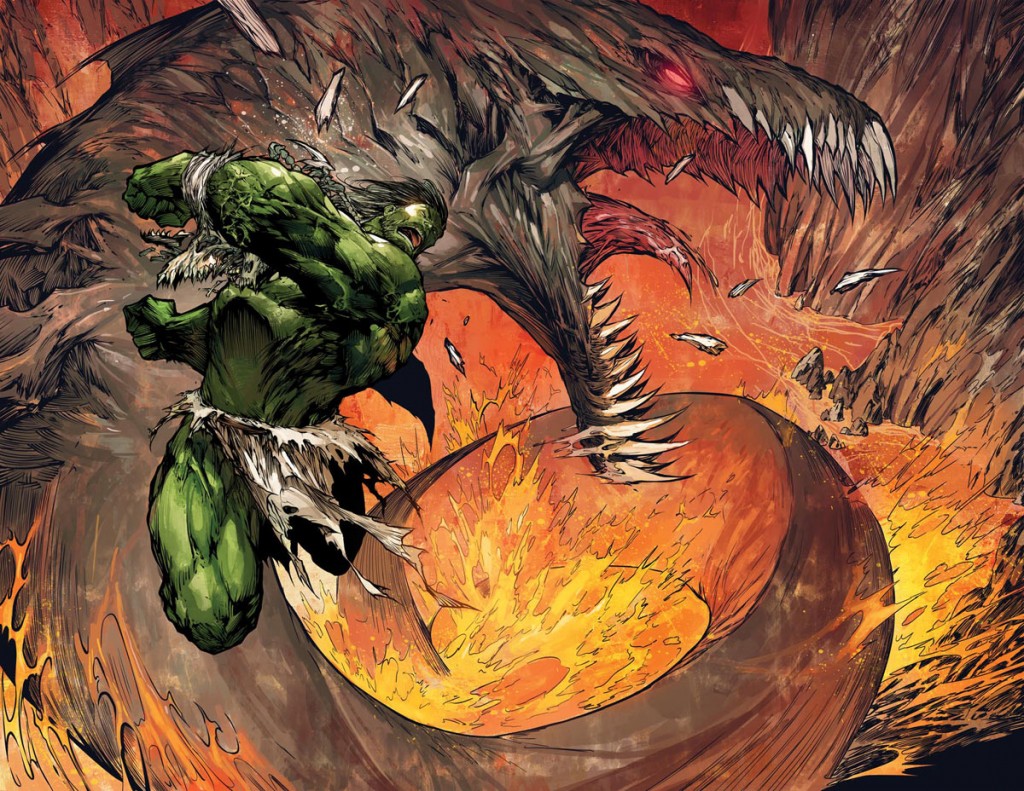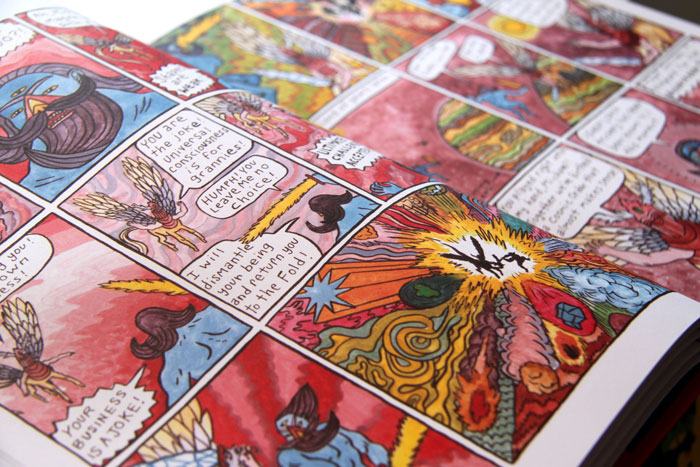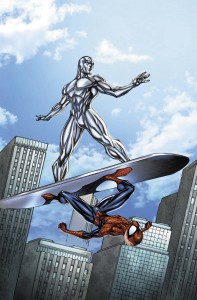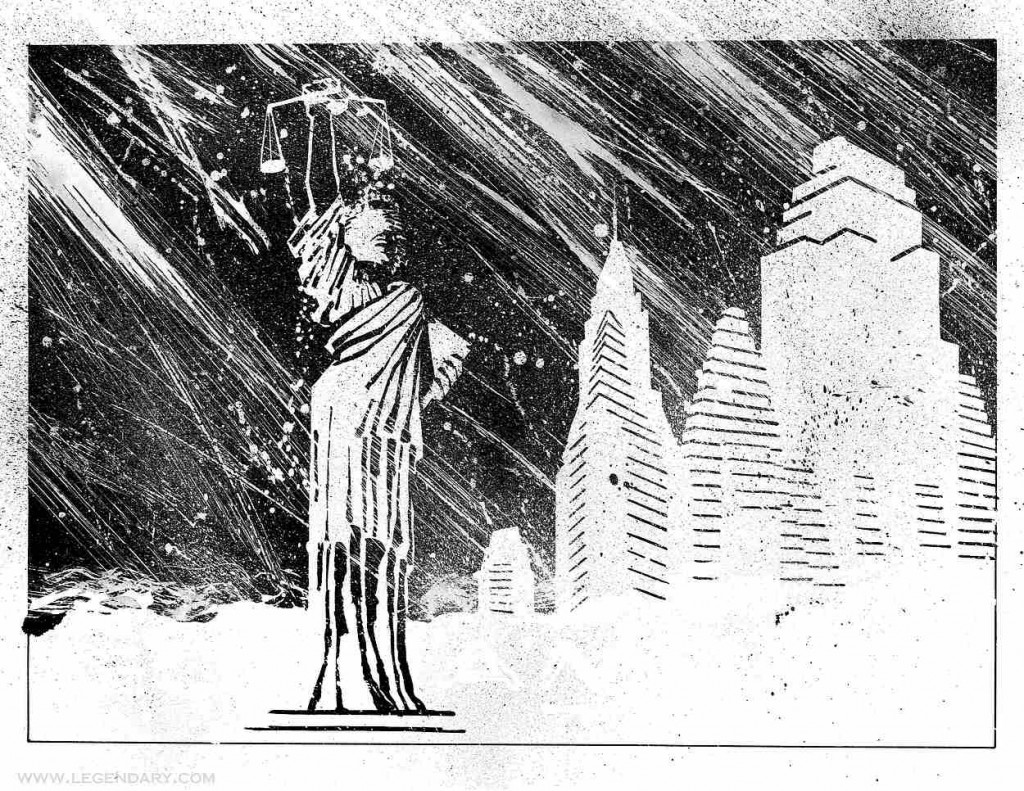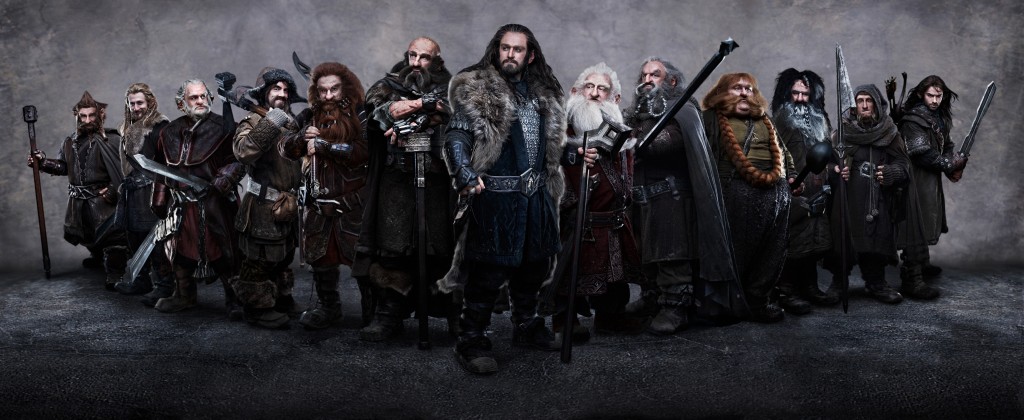Posts Tagged ‘comics’
Have a Comics Time all the time
August 16, 2011I’m pleased to announce that the Comics Reviews section of the sidebar is now fully up to date. All of my recent Comics Time reviews have been added, and all the links lead to the relevant review here at seantcollins.com rather than at my old site. That’s in the neighborhood of 500 reviews. Please browse and enjoy.
Comics Time: Tales Designed to Thrizzle #5
August 16, 2011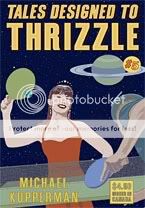 Tales Designed to Thrizzle #5
Tales Designed to Thrizzle #5
Michael Kupperman, writer/artist
Fantagraphics, 2009
32 pages
$4.50
Buy it from Fantagraphics
(Originally posted at this blog’s previous location on May 26, 2009; I am reposting it because it does not seem to have made the move to the current site.)
By now I’ve written about how Kupperman’s humor works at some length, so you’d think it would have occurred to me by now that his humor is an entirely different animal from the vast majority of humor comics. Which it is, insofar as it’s funny and most humor comics aren’t. But it wasn’t until this (ironically) prose-heavy issue that I realized he’s not doing gag comics at all. The only four-panel punchline-driven strip in this entire book, “Ever-Approaching Grandpa,” basically exists to give lie to the notion of the four-panel punchline-driven strip (and is own title). He’s not content with using just the words and the visuals. I think what Kupperman’s doing–with his long, digressive “stories,” with his riffs on old-fashioned comic-book covers, and so on–is using the stuff of comics itself as a locus of the comedy. A grid of panels implies continuity of action, so he uses that to present an increasingly bizarre and disjointed Twain & Einstein adventure with barely any internal cohesion whatsoever. We assume that captions or word balloons will comment on the visuals against which they are juxtaposed, so he creates a how-to arts-and-crafts strip that for no apparent reason is also a brutal noir (“How to Pattern Print with a Potato, Johnny”). We’ve come to accept certain visual cues as meaning a certain thing, so he literalizes them so that they mean something entirely different–a phone in the extreme foreground actually turns out to be a just-plain gigantic phone; a mother’s wagging finger radiates motion lines that turn out to be “super-vibrations.” In his way, Kupperman’s just as concerned with making comics’ formal aspects work for him as Chris Ware. In his way he’s every bit as effective. Goddammit this book is funny.
Go, read: Tom Spurgeon on his absence, his illness, and life in comics
August 14, 2011You won’t read anything better this year. You are the best, Tom.
Carnival of souls: Anders Nilsen, drawings of attractive ladies, Boardwalk Empire, more
August 14, 2011* Tremendous interview with Anders Nilsen about Big Questions by Alex Dueben on CBR. “It’s my newest book, but it’s also my oldest.” Wow, can you imagine? Big Questions was the first comic Nilsen ever did, and it’s about to be released in its finished 600-page form.
* Some of the Harry Potter movie people are working on a deal to make a mult-movie adaptation of Stephen King’s The Stand. That could certainly be very good, though in all likelihood it’ll be overwrought and mediocre with interesting moments like most big Hollywood versions of good ideas these days.
* Filing this away for when I’ve read the book: Hayley Campbell reviews Like a Sniper Lining Up His Shot by Jacques Tardi and Jean-Patrick Manchette for The Comics Journal.
* Apparently Julie Doucet’s cat carrier has sat at the bottom of the back stairs of the Fantagraphics office since 1993. This fits very well with my preexisting mental picture of the Fantagraphics office.
* Well this is certainly a great ad for The Beguiling that Michael DeForge drew. How many characters do you recognize? I got all but three or four, I think.
* Uno Moralez is creepy and sexy.
* Yow–this new group sketchblog Ashcan All-Stars is doing Sin City and doing it well. In order: James Stokoe, Moritat, Sheldon Vella.
* No, seriously, it’s uncool how much I’m enjoying The Walking Dead‘s woes. They’ve all got mothers, you know?
* If there’s one thing HBO knows how to do, it’s make trailers that make their shows look like the baddest things ever. Boardwalk Empire is pretty great regardless, though.
STC at SPX
August 11, 2011I’ll be attending the Small Press Expo in Bethesda, Maryland this year, hopefully with wife and kid in tow. As you can imagine I am very much not the star of the Collins Family Show, but on the off chance that you’re still interested in seeing me, I’ll be moderating a couple of panels with some of my favorite cartoonists on Saturday, September 10th.
Excruciating Detail: Drawing the Grotesque
1:00 pm | White Flint Amphitheater
Historical comics ranging from Chester Gould’s Dick Tracy to the horror comics of the 1950s have specialized in images of the grotesque. Sean T. Collins will speak with cartoonists Lisa Hanawalt (I Want You), Benjamin Marra (Night Business), Tom Neely (The Wolf), and Johnny Ryan (Prison Pit) about the act of drawing horrific, visceral, visual detail in contemporary comics that speak to horrors that are both timeless and contemporary.
Craig Thompson Q+A
3:00 pm | White Flint Amphitheater
Following on the heels of his sensitive tale of departure Good-bye Chunky Rice, Craig Thompson came to national attention in 2003 with his massive, autobiographically-based graphic novel Blankets. Eight years later, Thompson has completed his next graphic novel, Habibi, a love story set in the Middle East and patterned after the visual cadences of Arabic calligraphy and Islamic art. Thompson will discuss his work in a conversation with Sean T. Collins.
You can find the entire slate of programming here. Bill Kartalopoulos put together quite a line-up. Hope to see you there!
Carnival of souls: My top 10 comics of all time, Matt Rota, Cindy & Biscuit, more
August 10, 2011* Click here to find a list of my ten favorite comics, more or less.
* My friend and collaborator Matt Rota has an art show opening up on Saturday, August 13 at L.A.’s Copro Gallery. The art in it looks like this:
* Jeez it is a pleasure to witness Joe McCulloch’s return to writing about alternative comics, specifically one of my top three favorite cartoonists and one of the very best comics short stories of all time: Phoebe Gloeckner and “Minnie’s 3rd Love.”
* Meredith Gran on the importance of supporting women cartoonists buy paying them to draw comics.
* Ben Morse on the best of Ultimate Spider-Man, which has been a very good comic for more than a decade.
* The degree of schadenfreude I’m feeling from The Walking Dead TV show’s behind-the-scenes woes is unseemly.
* Six ancient things that were probably built by aliens. Nearly a decade and a half after I first read Illuminatus! and 20-25 years after I first heard of Stonehenge and Atlantis and Easter Island and so on, this kind of thing still gives me chills.
* There’s not a whole lot in comics right now more fun than the way Dan White draws Cindy & Biscuit launching themselves through the air at monsters they’re about to dispatch
* I can certainly support the idea of Miles Fisher as a male, American, horror/parody-video-making Robyn. (See also.) Bonus points for casting Steffi from The Bold and the Beautiful in the Kelly Kapowski role and the closing homage to Hellraiser III. (Now there’s a sentence I never thought I’d write.)
Comics Time: The Heavy Hand
August 10, 2011The Heavy Hand
Chris C. Cilla, writer/artist
Sparkplug, 2010
108 pages
$14.99
Buy it from Sparkplug
Buy it from Amazon.com
Fascinating book, this. It combines the textural, noise-based visual aesthetic of caves and monsters and melty stuff that you may have seen from many of Chris Cilla’s fellow contributors to the Paper Rodeo and Kramers Ergot anthologies with the down’n’out beer-swillin’ shit-talkin’ big-schnozzed characters of ’90s altcomix (big noses are to alternative what big feet were to the underground), so right off the top it’s doing something unexpected. And in the same way that the art is both densely intense and breezily funny, the story somehow coheres from jokey banter, grand-guignol monster attacks, and surreal non sequitur splash pages into an utterly convincing world. The Heavy Hand is basically the tale of Alvin Crabshack, somewhat feckless young guy who picks up stakes and moves from the city to a remote research site in hopes of bluffing his way into the employ of a scientist he admires, at which point he is drawn into a crescendoing series of bizarre science-fictional events — and it works great on both sides of that descriptive sentence’s comma.
Regarding the first half, Cilla’s command of the details of a young life not particularly well lived is substantial. Just for example, look at the way he differentiates between the two women Alvin is (duplicituously) dating by how he dresses both their rooms and themselves — the first has a neat haircut and sits in bed reading one book among many well-ordered shelves, candles and wine glasses strewn here and there; the second we meet as she cracks open a beer and picks a cassette tape off a table sporting a used ashtray and half-eaten dishes, all while bare-ass naked — while giving both sequences a sordid, stiff-nippled sexiness, a squalid heat that comes from lying to someone you know intimately and resent at least as much as you enjoy.
Of course, the second woman has a duck’s beak instead of a nose, which leads us to the strangeness. Obviously this wouldn’t be the first time an alternative comic featured unexplained anthropomorphism in an otherwise realistic setting, so I didn’t pay it much attention — nor the weird, wordless opening sequence in which some kind of ghostly scientist fixes both a machine and a cup of coffee by pissing all over them. But as Alvin’s journey progresses, we come to learn that not only is he basically lying his way into working with his academic idol, but the work he’ll be doing is considerably more odd and dangerous than the book’s opening makes it sound. Rival grant-sponsored teams plumb a system of caverns and underground rivers for giant eggs that contain dead reptiles, while huge and deadly one-eyed protoplasmic creatures devour their pack donkeys…which in turn hearkens back to tall tale about a curse on a nearby town that led to its affliction with these strange animals…which we suddenly realize relates to the odd interstitial splashes and spreads depicting a mustachioed man and giant spiders and so on…which we eventually learn aren’t the non-narrative interruptions they appear to be but an integral part of the story at hand…which culminates in a tour-de-force party sequence where the romantic entanglements and awkward interpersonal interactions of the beginning of the book come back into play. These competing, seemingly clashing narrative and visual threads slowly enmesh and intertwine so organically that you hardly notice, until suddenly you realize they’ve sewn up a structure so sturdy you could spend hours climbing around inside it.
My only complaint is that you don’t get that kind of time. As fun as that party scene is — I really love the way all of the dialogue is disconnected, with never more than two word balloons actually commenting on one another; it’s a great way to convey feeling out of place in an inebriated crowd — it eats up a huge amount of space relative to the densely plotted rest of the book, and rockets everything to its explosive conclusion way too fast. The Lynchian epilogue is as engrossing as anything else in the book, but it made me pine for a nonexistent much longer version, one that didn’t cut itself off right when it became apparent how rich and compelling it was. But since so much of the plot is driven by an anecdote about an inventor whose life basically had to blow up before he could do what would make him rich for the rest of his life, it’s hard for me to get too upset that the book itself follows suit. Wanting more is surely a sign that this smart, biting work of literary science-fiction comics did something right.
Carnival of souls: Ben Katchor, Jordan Crane, Jonny Negron, more
August 8, 2011* I literally cheered for this piece by the Comics Grid’s Katlheen Dunley on Ben Katchor and the world as a palimpsest.
* Chester Brown’s Paying For It: The Movie is probably not gonna happen.
* Jordan Crane’s The Last Lonely Saturday: The Movie actually has happened!
* News flash: Fantagraphics’ Jacob Covey-designed Carl Barks Disney Ducks comics are going to be very attractive.
* Tom Spurgeon’s description does a terrific job of selling Bill Mauldin’s Willie and Joe Back Home, but really, the cartoon on the cover speaks volumes. Can you imagine seeing this at the time? Lately it has seemed to me that deflating America’s self-image of World War II and its aftermath is vital to the country’s long-term health, and man, is this a shot to the face of those notions.
* Maybe I should just outsource this whole blog to Jonny Negron.
* And speaking of ADDXSTC “Hey look at this art” favorites, I don’t know if this Wei Yan piece is an homage to similarly formatted Renee French drawings, but either way, very nice.
* I won’t spoil the latest Zach Hazard Vaupen gag comic for you. Vaupen’s Rusted Skin stuff is fascinating to me, because comedically it’s totally gag comics, but visually it’s not at all. There’s nothing else like that.
* Okay, a Batman video game in which you have the option of playing as Frank Miller’s Dark Knight Returns Batman is a Batman video game I’d enjoy playing, but only if playing as that Batman.
* You know, it’s been way, way too long since I simply looked at a picture of Katee Sackhoff and went “guh.” Guh.
Carnival of souls: Special “San Diego detritus” edition
August 1, 2011* Daybreak author Brian Ralph is doing a diary comic about his time at the San Diego Comic-Con this year for The Comics Journal. So far, so great. It starts off jaunty and funny and actually kind of uplifting, until, thanks to cameos from Tom Devlin and Peggy Burns and some personal revelations, it suddenly starts feeling like an outtake from A Serious Man.
* And here’s a nice interview with him at Giant Robot, too. (Via Drawn & Quarterly.)
* Now you can watch the Hernandez Brothers spotlight panel at San Diego from the comfort of your own home, courtesy of The Comics Journal!
Love & Rockets from The Comics Journal on Vimeo.
* And here’s a brief history of Fantagraphics courtesy of CBR’s report on their 35th Anniversary panel.
* The Hooded Utilitarian is posting the results of its first-ever critics poll on the 115 best comics ever. I chipped in a list, which you’ll see eventually.
* Tom Spurgeon, Steve Bissette, and Tom Spurgeon again on the Marvel/Kirby case.
* Jason Adams reviews several recent-ish movies of semi-note: The Devil’s Double, Cowboys & Aliens, Crazy Stupid Love, and Sucker Punch. I’m with him on Zack Snyder’s action choreography — it’s nice to be able to tell what’s going on and what happened to whom when a punch is thrown.
* Michael DeForge turned 24 today; to celebrate, he posted afreakingnother terrific comic page.
* Finally, this essay hit me where I live: Middle-school history teacher Dwight Simon on all the ways we teach children to love war. The points on violence as a vector for redemption and violence as a supra-religion were depressingly on point. (Via Andrew Sullivan.)
Comics Time: Love and Rockets: New Stories #4
August 1, 2011Love and Rockets: New Stories #4
Gilbert Hernandez, Jaime Hernandez, writers/artists
Fantagraphics, August 2011
104 pages
$14.99
Buy it from Fantagraphics
Buy it from Amazon.com
Love and Rockets: New Stories #4 will turn any fan of Los Bros Hernandez into the host of The Chris Farley Show. “Remember? That time? When you drew Calvin’s plaid shirt? So that the plaid was always facing in the same direction? No matter how much Calvin moved?…That was awesome.” I am seriously finding it difficult, if not impossible, to review this comic without simply hitting the bullets-and-numbering button and whipping up a list of everything in it that amazed me. It would be a long list, too. But I’m abstaining as much as I can — to challenge myself for starters, and to avoid spoiling the comic for those of you who haven’t yet read it (which is probably most of you since it’s not out yet) for the most part. But I’m also holding off on that listicle because I think it’s a cheat. The fact of the matter is that while reading this book I discovered that I’m at least as attached to Ray Dominguez and Fritz Martinez, the protagonists of Jaime and Gilbert’s contributions respectively, as I am to a decent number of real people in my life. So sure, I could rattle off the ways in which Xaime and Beto continually prove themselves to be among the most graphically inventive and entertaining cartoonists alive some three decades into their careers — the crosshatching on Ray’s shirt and Maggie’s sofa; Gilbert’s use of wavy, puddle-shaped, impenetrable fields of black in his vampire story; the impact of the just-this-side-of-parallel lines of Angel’s body as she bends her leg to put on a high heel; the upside-down lava-lamp shape of Fritz’s legs in a skirt, used as an anchor for panel after panel of her simply walking around town with her agent ex; dredging up a long-ago, possibly long-forgotten character, drawing him as a late-middle-aged man in a way that makes him unrecognizable until you realize just how recognizable he is; the smashed-skull-as-cubist-masterpiece in Gilbert’s customary burst of horrifying ultraviolence; the holy shit moment when you realize the visual structure to that montage spread from Jaime’s story; Gilbert storming the ramparts of the vampire story and launching sex and violence back into it like payloads from a trebuchet; Jaime serving up a story whose snapshot style echoes comparable material from “Wigwam Bam” in significant and story-relevant ways; tracing the similarities and differences between Killer and Fritz via the characters they play, the use of their amazing bodies fraught with story information. And hey, look at that, I did rattle them off! But in the end, how it looks pales in insignificance next to what happens, because making it look that good is a means to the end of imparting just how much what happens matters. Ray’s shirt and Fritz’s legs, the shadow of the vampire and the structure of the montage — they’re just landmarks to remind you where you were when you found out if Ray and Fritz and Maggie were going to get happy endings, or not. It’s the easiest thing in the world to understand, and it’s the hardest thing in the world to do, and it’s magic, pure magic, to do it this well.
Carnival of souls: DC, DeForge, HBO execs on Game of Thrones, more
July 30, 2011* I’m impressed by DC’s response to the recent debate over the number of women creators it employs. Anyone who says “Well they had to say something, it was bad PR” has obviously not been following the comics industry very long. When you ask someone publicly to do something, and they say “You’re right, we’ll try to do better on that,” that’s a really good thing, especially on an issue like this. Good for DC.
* Grant Morrison in conversation with Neil Gaiman. A fun quote from Gaiman about Morrison: “Whenever I see you now, you are this glorious bird of paradise, but I remember, just as for you I will always be a nervous, hungry young journalist, I remember you as a kid in a black raincoat, incredibly shy. The thing that would get you animated was the point where you’d start talking about a story, and you would come to life.”
* There’s a Marvel/Gary Friedrich lawsuit going on over Ghost Rider right now as well.
* It’s always fun and informative to hear Tom Brevoort talk about how the sausage gets made.
* HBO execs talked about Game of Thrones in a reasonably interesting fashion recently: They’re standing very firm on the 10-episodes-per-season issue, which is unfortunate, but other than that they seem very supportive of a long run and not apt to try to cram too much material (i.e. the entirety of the fatter volumes) into a single season as opposed to spreading it out.
* RoboCop vs. Transformers vs. Hanawalt vs. Harbin.
* Uno Moralez is really one of the best.
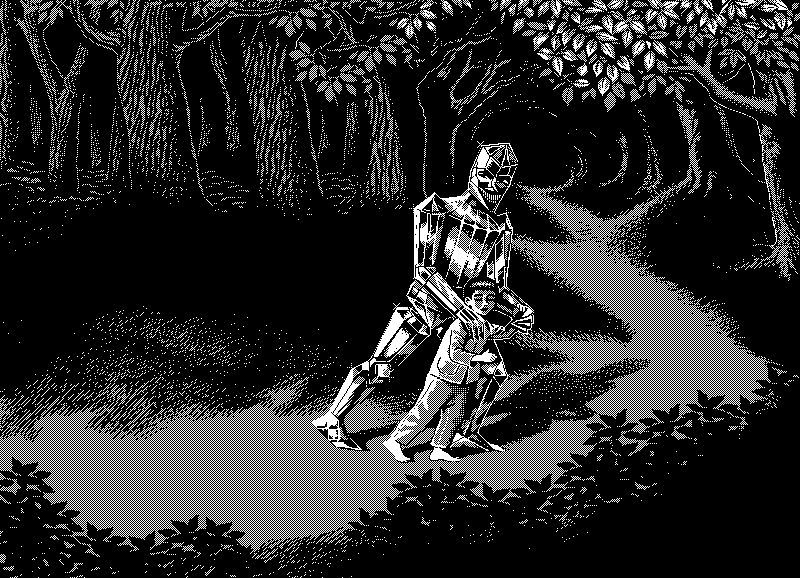
* Funny stuff and sexy stuff from Michael DeForge.
* The Sylvester Stallone Character Name Generator made me laugh very hard. (Via Mike Barthel.)
Carnival of souls: Marvel wins Kirby lawsuit, Beto’s going back to Palomar, Jordan Crane’s new book, more
July 28, 2011* Jack Kirby’s heirs have lost their copyright suit against Marvel, which centered on whether or not Kirby’s creations/co-creations for the company constituted work for hire. The judge ruled that they did: “If it does [constitute work for hire], then Marvel owns the copyright in the Kirby Works, whether that is ‘fair’ or not.” One of the few nice things you can say about “nerd court” is that in nerd court you can concentrate on whether or not a thing is fair. Anyway, in the real world it’s not clear to me whether this is something that can now go to a higher court or whether this settles the matter.
* Recently on Robot 6:
* Gilbert Hernandez will be returning to Palomar with a story in Love and Rockets: New Stories #5, out next year. That surprised me, given his recently expressed feelings about his Palomar material, but I’m as happy about this as I am about any new Beto comics.
* Jordan Crane’s new kids’ book Keep Our Secrets uses heat-sensitive color-changing ink to reveal hidden images. Jordan Crane is pretty amazing, basically.
* Listen to an audio clip of Dan DiDio addressing the number of women creators at DC right now. Check out Laura Hudson’s column on the subject, too. Remember, “We have to stop thinking of it as a quota thing and think of it as a common-sense thing.”
* Marvel is once again offering a variant cover for one of its event comics in exchange for unsold copies of DC’s event comics. Almost everything about this story and all the arguments for and against it is funny to me.
* Grant Morrison spitballs an Atom revamp in which a limit to his size-shifting abilities serves as a parameter for individual adventures. Sure, I’ll eat it.
* The Comic-Con organization’s WonderCon may be moving from San Francisco to Anaheim due to initial scheduling constraints, though as CCI’s David Glanzer tells Tom Spurgeon at the link, it’s far from a done deal because San Fran has changed its mind about the scheduling thing. I hate to see a nice city like San Francisco lose a show, but at the same time you have to imagine that operating a con in Los Angeles itself (more or less) would make a lot of sense for the organization.
* Jeet Heer reviews Ben Katchor’s The Cardboard Valise for the Los Angeles Review of Books. I like that he focuses on the very nearly physical pleasure of reading Katchor comics, as immersive an experience as contemporary comics offers. (Via Tom Spurgeon.)
* J. Caleb Mozzocco’s Robot 6 review of Chester Brown’s Paying For It describes Brown’s appearance in the book as “a grim, expressionless little bobble-headed skeleton…like Harold Grey drawing of the male half of the couple in Grant Wood’s American Gothic.” That’s worth the price of admission for the review right there.
* This is fun: My pal T.J. Dietsch, a total newcomer to the work of Jim Woodring, decided to try Weathercraft. It was a successful experiment. T.J., try Congress of the Animals next!
* I was quite happy to discover Jason Sandberg’s “Kurtzberg” series of paintings at Kirby-Vision, which pay homage to Jack Kirby yet have a static surrealism all their own. You can find more by scrolling through Sandberg’s site.
* Jesus, someone made animated gifs out of Junji Ito’s Uzumaki. Why you do dis to me, Dimmy? Why?
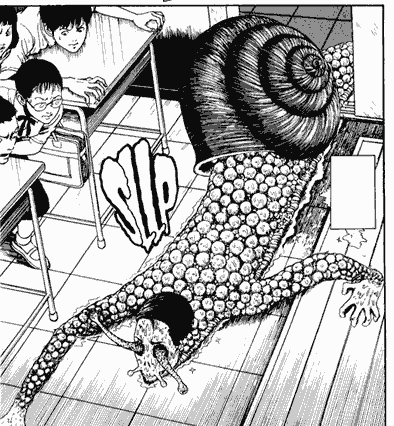
* Finally, I had no idea that there was a dispute over who created my beloved He-Man and the Masters of the Universe. That’s the subject of the documentary Toy Masters, which also chronicles the behind-the-scenes strife between the makers of the television series (J. Michael Straczysnki among them), who saw the job as no different from any artist’s or entertainer’s, and the makers of the toys upon which the show was based, who saw the show as a 30-minute commercial. Errol Morris it ain’t, stylistically speaking, but it’s fascinating if you’re into He-Man and probably still pretty funny if you aren’t. (Via Topless Robot.)
Carnival of souls: Los Bros Hernandez, Jordan Crane, Jonny Negron, more
July 27, 2011* This report on the Gilbert, Jaime, and Mario Hernandez spotlight panel at Comic-Con from CBR’s Sonia Harris makes for fascinating reading. All three brothers are really astute commentators on one another’s work.
* Kevin Czapiewski talks about one of my favorite things about Jordan Crane’s comics: his pictogram sound effects.
* Don’t let Nick Gazin’s short sell in the intro fool you: His interview with Jonny Negron for Vice is fun and informative, and contains a lot of Negron art I haven’t seen to boot.
* Hey, Vasilis Lolos is finally working on a second volume of Last Call! Now whatever happened to The Pirates of Coney Island?
Comics Time: Congress of the Animals
July 27, 2011Congress of the Animals
Jim Woodring, writer/artist
Fantagraphics, June 2011
104 pages, hardcover
$19.99
Buy it and read a preview at Fantagraphics.com
Perhaps I should have seen it coming after the palpable (if fleeting) triumph of good over evil that comprised the climax of Weathercraft, Jim Woodring’s previous standalone graphic novel set in the world of his funny-animal avatar Frank. Regardless, I’ll admit it: I did not expect to read a Frank book whose final panel made me go “Awwww!”
It’s true that in Weathercraft, Frank’s hapless antagonist Manhog achieves enlightenment that for a short while allows him to become an elemental force of kindness, justice, and the security of a fundamentally benevolent order to the universe. But it’s only for a short while — the equilibrium restores itself, and he, the insouciant Frank, and the jauntily predatory Whim go back to their old ways. According to Woodring’s typically dense and hilarious jacket copy, we have the Unifactor, the familiar world of bulbous buildings and shoggoth-like plant deities in which Frank and his cohorts dwell, to thank for this state of affairs. Woodring calls the Unifactor “the closed system of moral algebra into which Frank was born, where “in the end, nothing really changes,” and where “Frank is kept in a state of total ineducability by the unseen forces which control that haunted realm.”
The difference here — and I’m not 100% convinced this would have been clear if Woodring hadn’t said so straight out on the jacket, but be that as it may — is that this time around, Frank leaves the Unifactor. Woodring’s customary Rube Goldbergian plot contrivances force Frank into a state of indentured servitude that ends with him on the lam. The journey positions Frank in the midst of various grown-up concerns, such as home ownership, property loss, commerce, employment, amusement, leisure, sex (in the form of what appears to be an angelic anthropomorphic vagina guarded by the giant disembodied head of a Dr. Seuss character), and religion (in the form of nude, beefy men with gaping chasms where their faces are supposed to be, whose ability to expose their guts at will and induce others to do so literally knocks poor Frank out with its disgustingness and is perhaps Woodring’s most troubling sequence since Manhog flayed his own leg); in other words, it’s a bit like Pippin. Normally we’d expect nothing to come of all this, save for an opportunity to marvel at Woodring’s buzzy, vibrating line, proficiency with creature design, and ability to distill unpleasant shit into slightly sinister slapstick adventures for his dog-cat-bear-mouse-thing hero. But the journey takes Frank so far afield that at some point (probably when he gets lost at sea and washes up on some distant shore) he ends up outside the Unifactor’s confines. New information can now enter his world, in the form of a female Frank-like character who lives in a house shaped like Frank. And at that point all hell breaks loose…which in a Frank comic is to say it doesn’t break loose at all.
Somehow, Frank has gained the ability to interact with another being without immediately sizing up the best way to have fun with, or at the expense of, that being, consequences be damned. They chat. They laugh at the bullying creatures who attacked him earlier, and blush at both having got such a kick out of it. (See, he hasn’t been brushed totally clean of his sins — as we see here and elsewhere, both he and his new pal still have a bit of an empathy deficit.) She protects him from the siren song of that angelic vagina-thing. She helps him return home, to the delight of his pets Pupshaw and Pushpaw, who seem overjoyed to find that their master has found his other half. But what really moved me is their simple physical interaction: They hug. I’m “awwww!”ing just thinking about it. That physical act is an act of grace on Woodring’s part, an escape from the mere hedonism or fight-or-flight responses that have been the sole custom of Frank’s world before now. It’s a new, rewarding emotion, embodied. And despite the break it marks from the world of Frank as we knew it, it fits, since isn’t embodying emotion what Frank stories have always been all about?
Carnival of souls: Fan entitlement, Holy Terror, Supergods, more
July 26, 2011* I posted Tom Brevoort’s comments on fan entitlement on Robot 6, and to my surprise, the ensuing comment thread largely cosigned his statement, as well as similar recent sentiments from Grant Morrison and Bryan Lee O’Malley. I thought about all this stuff today while flipping through Morgan Spurlock and Alba Tull’s surprisingly delightful photo book Comic-Con Episode IV: A Fan’s Hope. The vision of Comic-Con and nerd culture presented in that book is, I’m sure, baffling or even troubling to some comics readers — cosplay, not comics, is its centerpiece; at a glance I’d guess Hollywood personages outnumber comics creators and publishers; and Tull’s portraits of Moto Hagio share a page with her pictures of Gareb Shamus. That said, it’s a picture of Nerd Triumphalism that is, in fact, triumphant. It’s not a bunch of angry, snarky naysayers insulting people and poo-pooing books and movies that haven’t even come out yet — it’s a vibrant, diverse (lots of women, lots of non-white people, lots of kids, even people in wheelchairs) selection of weirdoes, geeks, and creative types, coming together because they’re all excited about the stuff they love. If the people-power aspect of Comic-Con were the public face of nerddom all year round, nerddom would be a lot easier to support, and the crasser, more exploitative mass-marketing aspects of the show would be easier to ignore.
* Frank Miller talks Holy Terror in long-war terms I now find as dispiriting as his increasingly untethered cartooning is invigorating.
* Paul Gravett reviews Grant Morrison’s Supergods, with a focus on whether Morrison’s love of the superhero concept has caused him to undervalue the regular humans responsible for it. (Via Tim Hodler.)
* Dan Conner and Omar are joining the cast of Community. My goodness!
* Wow, Colleen Doran’s concept art for a Wonder Woman costume redesign is lovely.
* “Turtle City” is a deeply cool commission by Theo Ellsworth.
* This assembly of 80 different fan covers of “Black Dog” by Led Zeppelin is almost moving in how well it conveys the simultaneous playfulness and brute force of that almighty riff. (Via Whitney Matheson.)
Comics Time: Citizen Rex
July 26, 2011Citizen Rex
Mario Hernandez, writer
Gilbert Hernandez, artist
Dark Horse, June 2011
144 pages, hardcover
$19.99
Buy it from Amazon.com
For today’s Comics Time review, please visit The Comics Journal.
Carnival of souls: Special “San Diego Comic-Con follow-up” edition
July 25, 2011* San Diego news and views continue to filter in…
* I missed this when it went up last week, but the great Tom Spurgeon suggested several potential stories to watch at this year’s Comic-Con just before it opened — I’d have been most interested in items 3, 4, 5, 7, and 8. The analysis is still worth reading, as is today’s follow-up post in which Spurge offers his take on how the con went this year.
* ICv2’s Milton Griepp gave calculating the total size of the digital-comics market the old college try at the ICv2 Conference at SDCC. The numbers he came up with are small, although they are growing rapidly. That stands to reason: Most companies simply don’t have those avenues open for business the way that making more money from them would require. But that’s obviously changing.
* Topless Robot’s Rob Bricken wonders: If a promotional video is screened at Hall H, but no one on the internet can see it, does it make a sound?
* I’m curious about the Jason Aaron/Marc Silvestri Incredible Hulk relaunch. And I’m super-curious about whoever its colorist is. That fire is lovely.
* In other news…
* Jesse Moynihan’s Forming Vol. 1 is now available from Nobrow Press. It looks gorgeous.
* My Robot 6 colleague Tim O’Shea interviews new B.P.R.D. artist Tyler Crook, who’s got some Guy Davis-sized shoes to fill with his first published professional comics gig.
* Tom Brevoort on what fans are entitled to:
Writers are writers because they know how to do what audiences don’t know how to do–tell stories that affect you and move you. It’s way tougher than it looks. Storytelling isn’t a democracy, you don’t get a decision in how the stories go. All you get is your one vote, with your dollars or your feet.
Does whatever a spider can
July 25, 2011SPIDER-MAN #19
Written by J.M. DEMATTEIS & SEAN COLLINS
Penciled by CLAYTON HENRY
Cover by ALE GARZA
WHAT HAPPENS WHEN SPIDER-MAN WIELDS THE POWER COSMIC?! The Silver Surfer is POWERLESS in New York, and it’s up to Spidey to set things right! Will Spider-Man be able to find the Sentinel of the Spaceways in time?! J.M. DeMatteis (AMAZING SPIDER-MAN) and Clayton Henry (SPIDER-GIRL) stop by this month to bring you THE POWER COSMIC! Then, the hunt is on as Spider-Man goes toe-to-toe with KRAVEN in the heart of New York’s concrete jungle!
32 PGS./All Ages …$2.99
—
I wrote a Spider-Man comic that comes out in October. I really couldn’t be happier about it, and neither could Young Sean T. Collins, who would watch Spidey on The Electric Company and Spider-Man and His Amazing Friends, and receive Spider-Man comics from the Te-Amo across from St. Catherine of Siena in Franklin Square, New York as a reward for behaving himself in church on Sundays. Thank you to Ben Morse, Warren Simons, Alejandro Arbona, Kiel Phegley, Steve Wacker, and especially Tom Brennan, who helped make this happen.
What I didn’t know at the time I wrote my story, which features Kraven the Hunter in the villain role, is that the man responsible for my love of Kraven, J.M DeMatteis of Kraven’s Last Hunt fame, would be writing the other story in the issue. No pressure or anything!
Keep your eyes peeled, or perhaps even ask your local comic shop to order one for you. I hope you enjoy it!
Carnival of souls: Special “San Diego Comic-Con Days 3&4” edition
July 25, 2011* News of note from Saturday and Sunday at the San Diego Comic-Con:
* Fantagraphics is publishing the EC Comics Library, in a series of black-and-white volumes centered on individual creators rather than the famous EC titles. So instead of a big horror book with a bunch of dudes’ stuff from Tales from the Crypt or whatever, you’ll get a collection of Harvey Kurtzman’s war stories, Wally Wood’s suspense stories, Al Williamson’s science fiction stories, or Jack Davis and Al Feldstein’s horror stories. (That’s actually the initial line-up.) I’m excited about this project, not just because with Peanuts and Mickey Mouse and the Disney Ducks and Popeye and Krazy Kat and so on Fantagraphics has established itself as the best publisher of archival material, but because their approach here sounds like it’ll be more along the lines of what they’ve done for Jacques Tardi recently, or even the Gilbert and Jaime Hernandez Love and Rockets digests. They’re very good at that sort of thing, too. Anyway, Tom Spurgeon broke the news and interviewed Gary Groth about it.
* But wait, there’s more: Fantagraphics is publishing The Complete Zap Comix, collecting every issue of the seminal (and still ongoing!) underground comix anthology series in one giant slipcased collection. That link takes you to Robot 6, where my colleague Chris Mautner interviews Gary Groth about the project. Besides comics by R. Crumb, S. Clay Wilson, Spain, Robert Williams, Rick Griffith, Victor Moscoso, Gilbert Shelton et al, the collection will also include an oral history of Zap. Groth pegs the size at about 550 pages, but in the comments, associate publisher Eric Reynolds says it’s actually closer to 800. And there you have it, the “News of the Con” one-two punch.
* Marvel announced some of its post-Fear Itself plans, several of which center on writer Matt Fraction. Fraction is writing a new Defenders series co-starring Iron Fist, a character he helped revive to great effect a few years back. He’s also co-writing a bi-weekly series called The Fearless, which sounds kinda like it has a Brightest Day vibe, with Cullen Bunn and Chris Yost, illustrated by Mark Bagley and Paul Pelletier. And the big Dark Reign/Heroic Age-style umbrella label for the post-Fear Itself world will be Battle Scars. Here’s a pretty thorough panel report on these and other announcements.
* Brian K. Vaughan is returning to comics with a new science-fiction series called Saga, illustrated by Fiona Staples and published by Image.
* Here are your 2011 Eisner Award winners. Congratulations to my colleagues at Comic Book Resources, and to the delightful Jim McCann. It’s also nice to see Jacques Tardi’s It Was the War of the Trenches earn some recognition.
* In other news…
* Clive Barker says Abarat III will be out at the end of September. Looking forward to it.
Carnival of souls: Special “San Diego Comic-Con Days 1&2” edition
July 22, 2011* Here are some highlights from Thursday and early Friday at the San Diego Comic-Con…
* I recommend following Robot 6’s CCI2011 tag for your San Diego news needs. Tom Spurgeon is also keeping a running log of the major comics publishing announcements, with occasional commentary, at his recently revived Comics Reporter site — that’ll be worth checking daily as well.
* Pyongyang/Shenzhen/Burma Chronicles author Guy Delisle’s next travelogue will be Jerusalem: Chronicles from the Holy City, which will take place during the “Operation Cast Lead” Gaza War. That’s something to look forward to, though as I said at Robot 6, it won’t be without controversy. (I’ve already gotten one condemnatory Google Alert hit for that post.)
* Marvel will be releasing day-and-date digital versions of its major Spider-Man and X-Men comics. If you go in for the Marvel Movie Conspiracy Theory, you’ll note that these are the two major franchises that Marvel Studios doesn’t own the rights to, rather than the Avengers and their associated characters. Marvel says they’ll start rolling out same-day digital copies of their other titles at logical jumping-on points, like first issues or the start of major new storylines.
* Sticking with the digital beat, Top Shelf is releasing digital versions of over 70 of its graphic novels.
* Frank Miller’s Holy Terror looks quite entertaining. I hadn’t realized it was in black and white, although I guess with Lynn Varley out of the picture it stands to reason.
* Chris Mautner interviews Brian Ralph about his first-person zombie survival story Daybreak. Fun fact: I have a short piece on this book in the August issue of Maxim!
* In the Friday iteration of DC’s daily panel on its “New 52” linewide relaunch, DC Co-Publisher Dan DiDio said planning for the relaunch began in October 2010, when 23 writers met to talk about the line’s direction. That’s the first firm date I’ve heard — it’s months before most of the speculation I’ve seen has pegged the initiation of the project — and the first time I’ve heard that that many writers were involved.
* In other news…
* I took a quick look at Grant Morrison’s recent comments on Siegel & Shuster’s claim to Superman on Robot 6.
* Speaking of which, Sam Bosma has been doing some extraordinary portraits of ASoIaF characters lately. Spoiler warning: Unless you’ve read the first four books, there are plenty of characters in there you probably haven’t met, so look out.
* Those two links remind me: Things have really been hopping over at my Song of Ice and Fire/Game of Thrones blog All Leather Must Be Boiled since I finished reading A Dance with Dragons. I’ve been posting a lot of commentary and links to interesting art and reviews, and Elio Garcia and Linda Antonsson, the good folks at the big-deal ASoIaF fan site Westeros.org, have been sending a lot of traffic my way, so there’s some good comment-thread action as well. Do check it out if that’s the sort of thing you’re interested in. My review of/braindump on A Dance with Dragons is a good place to start.
* Peter Jackson has released an official composite image of all 13 Dwarves from The Hobbit. Pretty, pretty good.
* Jason Adams runs down the major horror movies slated for release during the back half of 2011, none of which I will get to see, sob sob sob.


